Case Study: Boeing's Internationalization Strategy in China (MGT704)
VerifiedAdded on 2023/06/04
|21
|4894
|322
Case Study
AI Summary
This case study analyzes Boeing's international expansion strategy into the Chinese market, considering factors like market opportunities, challenges, and strategic alliances. It begins with an overview of Boeing and the Chinese airline industry, followed by an examination of cross-border strategic alliances. The analysis employs frameworks such as SWOT, CAGE, and VRIO to assess Boeing's decision to enter China. Porter’s Five Forces is used to analyze the competitive landscape. The report discusses various internationalization strategies like licensing, exporting, and global strategy, and concludes by identifying potential problems such as competition and cultural differences that Boeing may encounter in China. Desklib offers this and other solved assignments to aid students in their studies.
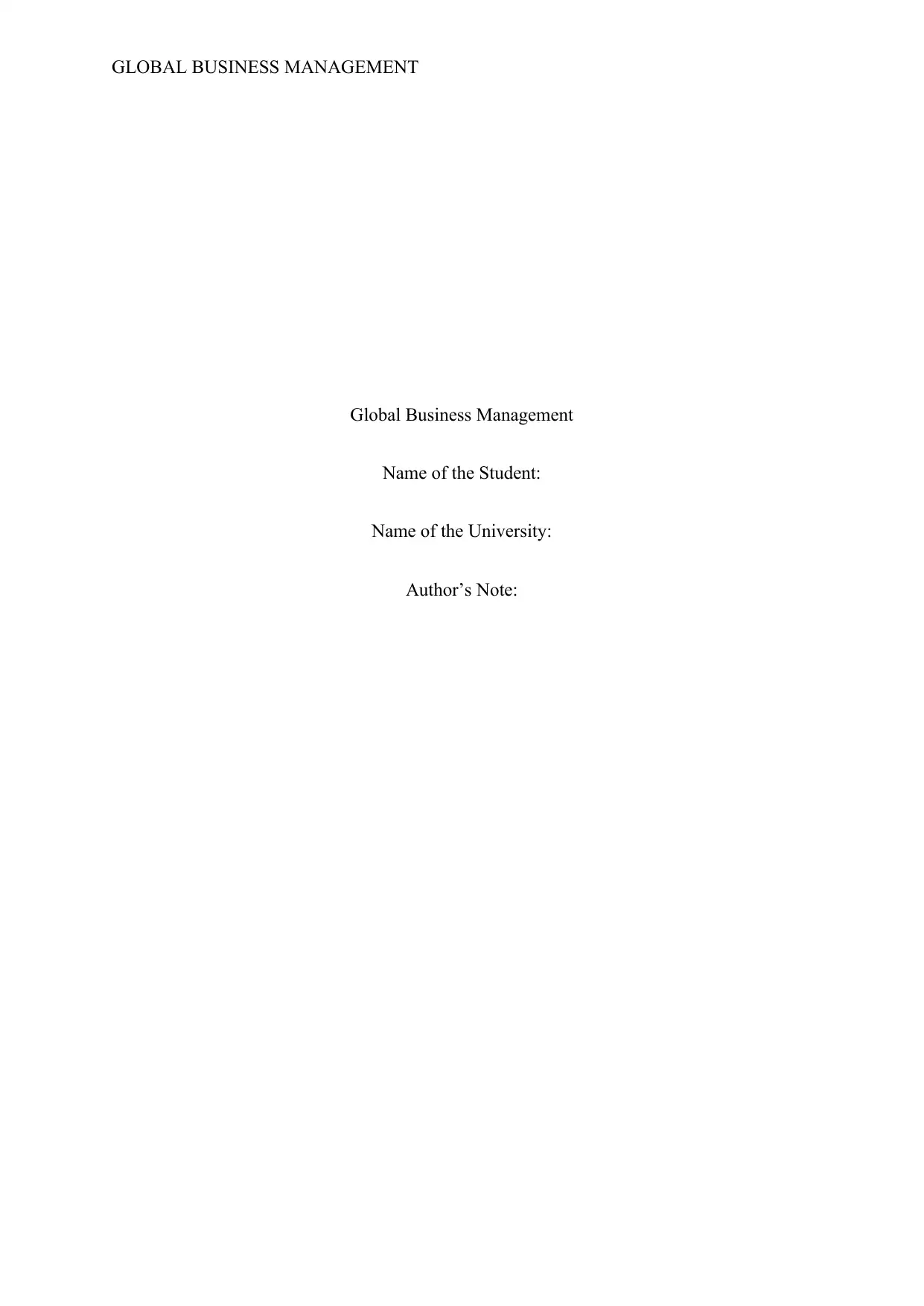
GLOBAL BUSINESS MANAGEMENT
Global Business Management
Name of the Student:
Name of the University:
Author’s Note:
Global Business Management
Name of the Student:
Name of the University:
Author’s Note:
Paraphrase This Document
Need a fresh take? Get an instant paraphrase of this document with our AI Paraphraser
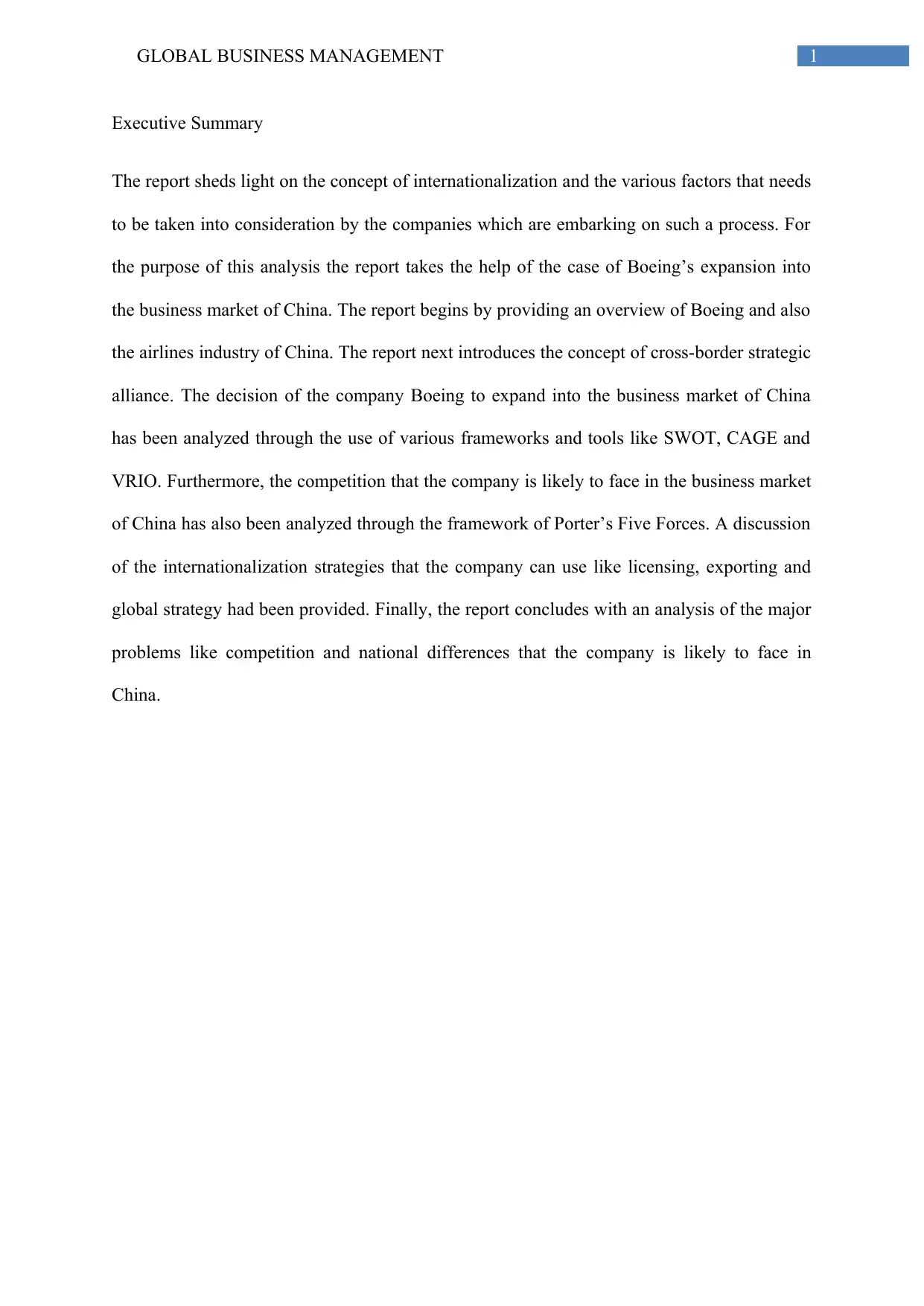
1GLOBAL BUSINESS MANAGEMENT
Executive Summary
The report sheds light on the concept of internationalization and the various factors that needs
to be taken into consideration by the companies which are embarking on such a process. For
the purpose of this analysis the report takes the help of the case of Boeing’s expansion into
the business market of China. The report begins by providing an overview of Boeing and also
the airlines industry of China. The report next introduces the concept of cross-border strategic
alliance. The decision of the company Boeing to expand into the business market of China
has been analyzed through the use of various frameworks and tools like SWOT, CAGE and
VRIO. Furthermore, the competition that the company is likely to face in the business market
of China has also been analyzed through the framework of Porter’s Five Forces. A discussion
of the internationalization strategies that the company can use like licensing, exporting and
global strategy had been provided. Finally, the report concludes with an analysis of the major
problems like competition and national differences that the company is likely to face in
China.
Executive Summary
The report sheds light on the concept of internationalization and the various factors that needs
to be taken into consideration by the companies which are embarking on such a process. For
the purpose of this analysis the report takes the help of the case of Boeing’s expansion into
the business market of China. The report begins by providing an overview of Boeing and also
the airlines industry of China. The report next introduces the concept of cross-border strategic
alliance. The decision of the company Boeing to expand into the business market of China
has been analyzed through the use of various frameworks and tools like SWOT, CAGE and
VRIO. Furthermore, the competition that the company is likely to face in the business market
of China has also been analyzed through the framework of Porter’s Five Forces. A discussion
of the internationalization strategies that the company can use like licensing, exporting and
global strategy had been provided. Finally, the report concludes with an analysis of the major
problems like competition and national differences that the company is likely to face in
China.
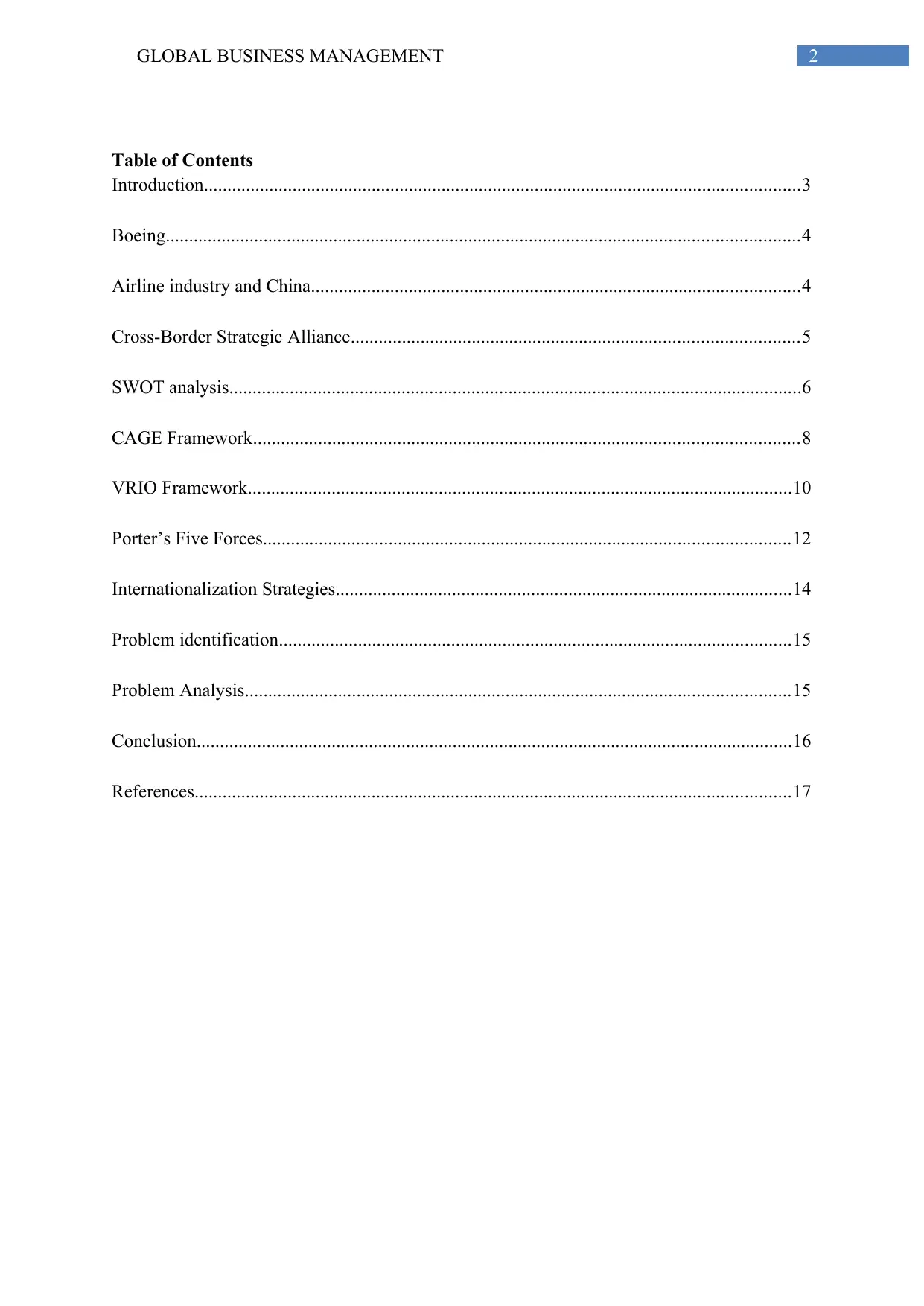
2GLOBAL BUSINESS MANAGEMENT
Table of Contents
Introduction................................................................................................................................3
Boeing........................................................................................................................................4
Airline industry and China.........................................................................................................4
Cross-Border Strategic Alliance................................................................................................5
SWOT analysis...........................................................................................................................6
CAGE Framework.....................................................................................................................8
VRIO Framework.....................................................................................................................10
Porter’s Five Forces.................................................................................................................12
Internationalization Strategies..................................................................................................14
Problem identification..............................................................................................................15
Problem Analysis.....................................................................................................................15
Conclusion................................................................................................................................16
References................................................................................................................................17
Table of Contents
Introduction................................................................................................................................3
Boeing........................................................................................................................................4
Airline industry and China.........................................................................................................4
Cross-Border Strategic Alliance................................................................................................5
SWOT analysis...........................................................................................................................6
CAGE Framework.....................................................................................................................8
VRIO Framework.....................................................................................................................10
Porter’s Five Forces.................................................................................................................12
Internationalization Strategies..................................................................................................14
Problem identification..............................................................................................................15
Problem Analysis.....................................................................................................................15
Conclusion................................................................................................................................16
References................................................................................................................................17
⊘ This is a preview!⊘
Do you want full access?
Subscribe today to unlock all pages.

Trusted by 1+ million students worldwide
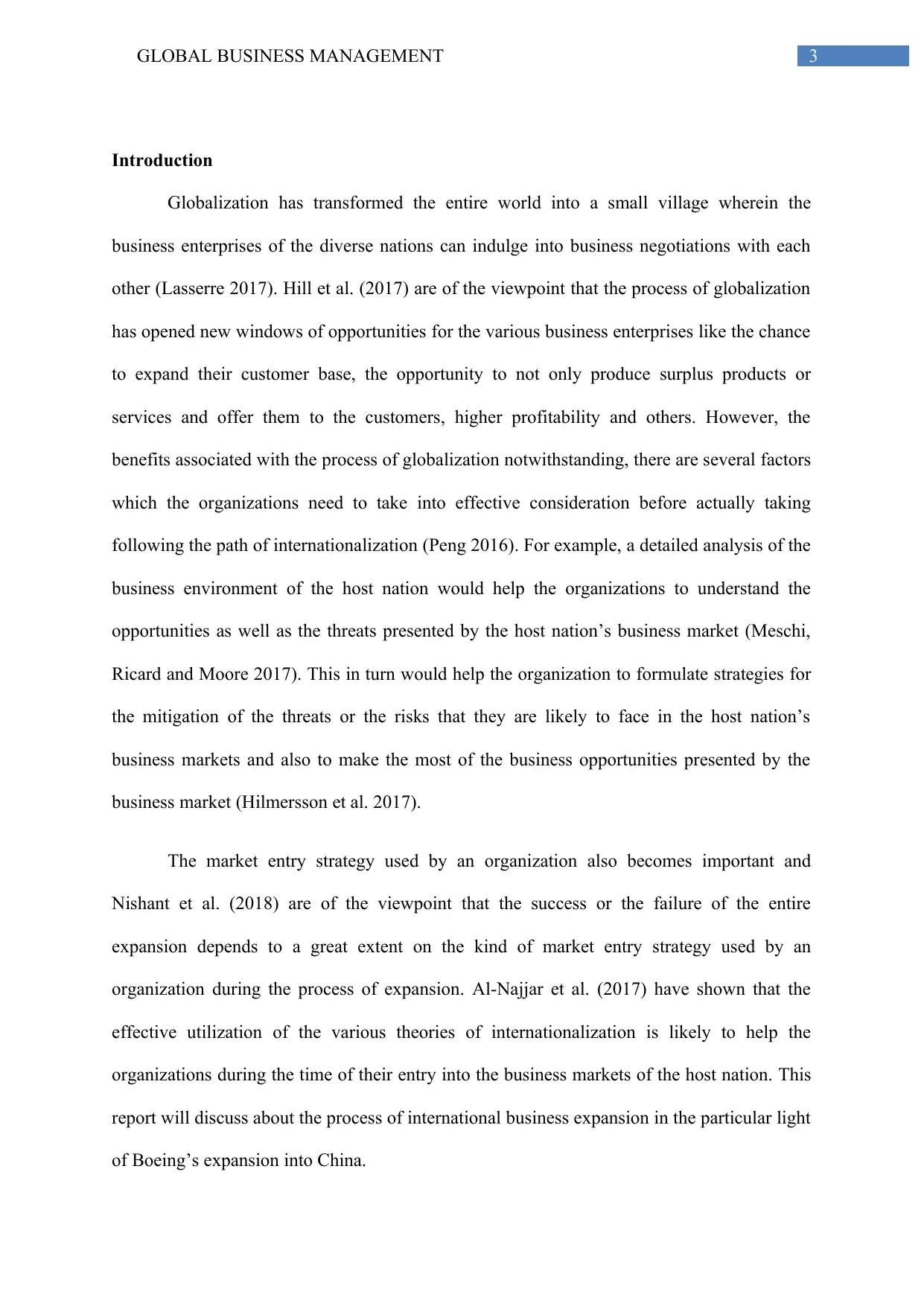
3GLOBAL BUSINESS MANAGEMENT
Introduction
Globalization has transformed the entire world into a small village wherein the
business enterprises of the diverse nations can indulge into business negotiations with each
other (Lasserre 2017). Hill et al. (2017) are of the viewpoint that the process of globalization
has opened new windows of opportunities for the various business enterprises like the chance
to expand their customer base, the opportunity to not only produce surplus products or
services and offer them to the customers, higher profitability and others. However, the
benefits associated with the process of globalization notwithstanding, there are several factors
which the organizations need to take into effective consideration before actually taking
following the path of internationalization (Peng 2016). For example, a detailed analysis of the
business environment of the host nation would help the organizations to understand the
opportunities as well as the threats presented by the host nation’s business market (Meschi,
Ricard and Moore 2017). This in turn would help the organization to formulate strategies for
the mitigation of the threats or the risks that they are likely to face in the host nation’s
business markets and also to make the most of the business opportunities presented by the
business market (Hilmersson et al. 2017).
The market entry strategy used by an organization also becomes important and
Nishant et al. (2018) are of the viewpoint that the success or the failure of the entire
expansion depends to a great extent on the kind of market entry strategy used by an
organization during the process of expansion. Al-Najjar et al. (2017) have shown that the
effective utilization of the various theories of internationalization is likely to help the
organizations during the time of their entry into the business markets of the host nation. This
report will discuss about the process of international business expansion in the particular light
of Boeing’s expansion into China.
Introduction
Globalization has transformed the entire world into a small village wherein the
business enterprises of the diverse nations can indulge into business negotiations with each
other (Lasserre 2017). Hill et al. (2017) are of the viewpoint that the process of globalization
has opened new windows of opportunities for the various business enterprises like the chance
to expand their customer base, the opportunity to not only produce surplus products or
services and offer them to the customers, higher profitability and others. However, the
benefits associated with the process of globalization notwithstanding, there are several factors
which the organizations need to take into effective consideration before actually taking
following the path of internationalization (Peng 2016). For example, a detailed analysis of the
business environment of the host nation would help the organizations to understand the
opportunities as well as the threats presented by the host nation’s business market (Meschi,
Ricard and Moore 2017). This in turn would help the organization to formulate strategies for
the mitigation of the threats or the risks that they are likely to face in the host nation’s
business markets and also to make the most of the business opportunities presented by the
business market (Hilmersson et al. 2017).
The market entry strategy used by an organization also becomes important and
Nishant et al. (2018) are of the viewpoint that the success or the failure of the entire
expansion depends to a great extent on the kind of market entry strategy used by an
organization during the process of expansion. Al-Najjar et al. (2017) have shown that the
effective utilization of the various theories of internationalization is likely to help the
organizations during the time of their entry into the business markets of the host nation. This
report will discuss about the process of international business expansion in the particular light
of Boeing’s expansion into China.
Paraphrase This Document
Need a fresh take? Get an instant paraphrase of this document with our AI Paraphraser
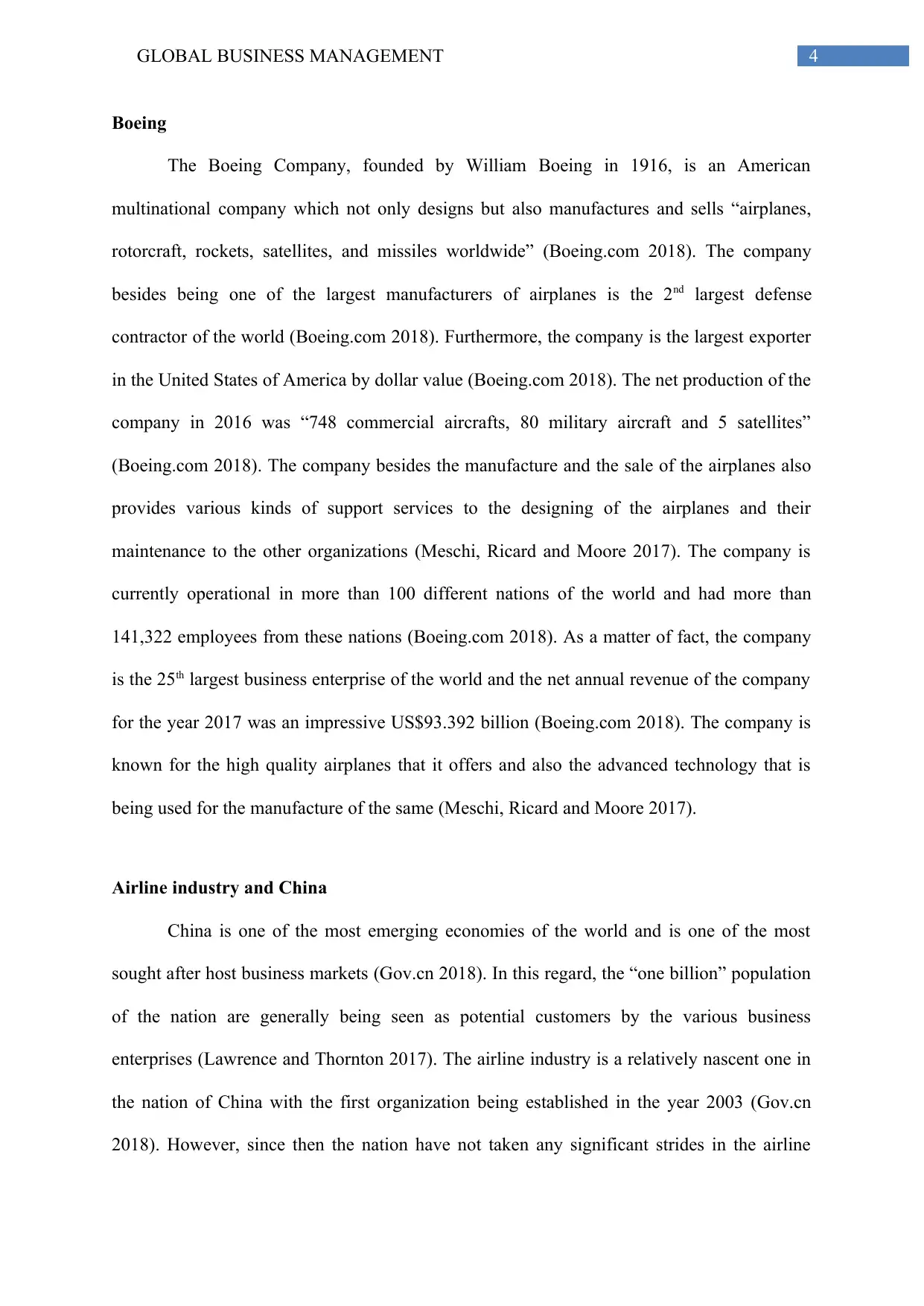
4GLOBAL BUSINESS MANAGEMENT
Boeing
The Boeing Company, founded by William Boeing in 1916, is an American
multinational company which not only designs but also manufactures and sells “airplanes,
rotorcraft, rockets, satellites, and missiles worldwide” (Boeing.com 2018). The company
besides being one of the largest manufacturers of airplanes is the 2nd largest defense
contractor of the world (Boeing.com 2018). Furthermore, the company is the largest exporter
in the United States of America by dollar value (Boeing.com 2018). The net production of the
company in 2016 was “748 commercial aircrafts, 80 military aircraft and 5 satellites”
(Boeing.com 2018). The company besides the manufacture and the sale of the airplanes also
provides various kinds of support services to the designing of the airplanes and their
maintenance to the other organizations (Meschi, Ricard and Moore 2017). The company is
currently operational in more than 100 different nations of the world and had more than
141,322 employees from these nations (Boeing.com 2018). As a matter of fact, the company
is the 25th largest business enterprise of the world and the net annual revenue of the company
for the year 2017 was an impressive US$93.392 billion (Boeing.com 2018). The company is
known for the high quality airplanes that it offers and also the advanced technology that is
being used for the manufacture of the same (Meschi, Ricard and Moore 2017).
Airline industry and China
China is one of the most emerging economies of the world and is one of the most
sought after host business markets (Gov.cn 2018). In this regard, the “one billion” population
of the nation are generally being seen as potential customers by the various business
enterprises (Lawrence and Thornton 2017). The airline industry is a relatively nascent one in
the nation of China with the first organization being established in the year 2003 (Gov.cn
2018). However, since then the nation have not taken any significant strides in the airline
Boeing
The Boeing Company, founded by William Boeing in 1916, is an American
multinational company which not only designs but also manufactures and sells “airplanes,
rotorcraft, rockets, satellites, and missiles worldwide” (Boeing.com 2018). The company
besides being one of the largest manufacturers of airplanes is the 2nd largest defense
contractor of the world (Boeing.com 2018). Furthermore, the company is the largest exporter
in the United States of America by dollar value (Boeing.com 2018). The net production of the
company in 2016 was “748 commercial aircrafts, 80 military aircraft and 5 satellites”
(Boeing.com 2018). The company besides the manufacture and the sale of the airplanes also
provides various kinds of support services to the designing of the airplanes and their
maintenance to the other organizations (Meschi, Ricard and Moore 2017). The company is
currently operational in more than 100 different nations of the world and had more than
141,322 employees from these nations (Boeing.com 2018). As a matter of fact, the company
is the 25th largest business enterprise of the world and the net annual revenue of the company
for the year 2017 was an impressive US$93.392 billion (Boeing.com 2018). The company is
known for the high quality airplanes that it offers and also the advanced technology that is
being used for the manufacture of the same (Meschi, Ricard and Moore 2017).
Airline industry and China
China is one of the most emerging economies of the world and is one of the most
sought after host business markets (Gov.cn 2018). In this regard, the “one billion” population
of the nation are generally being seen as potential customers by the various business
enterprises (Lawrence and Thornton 2017). The airline industry is a relatively nascent one in
the nation of China with the first organization being established in the year 2003 (Gov.cn
2018). However, since then the nation have not taken any significant strides in the airline
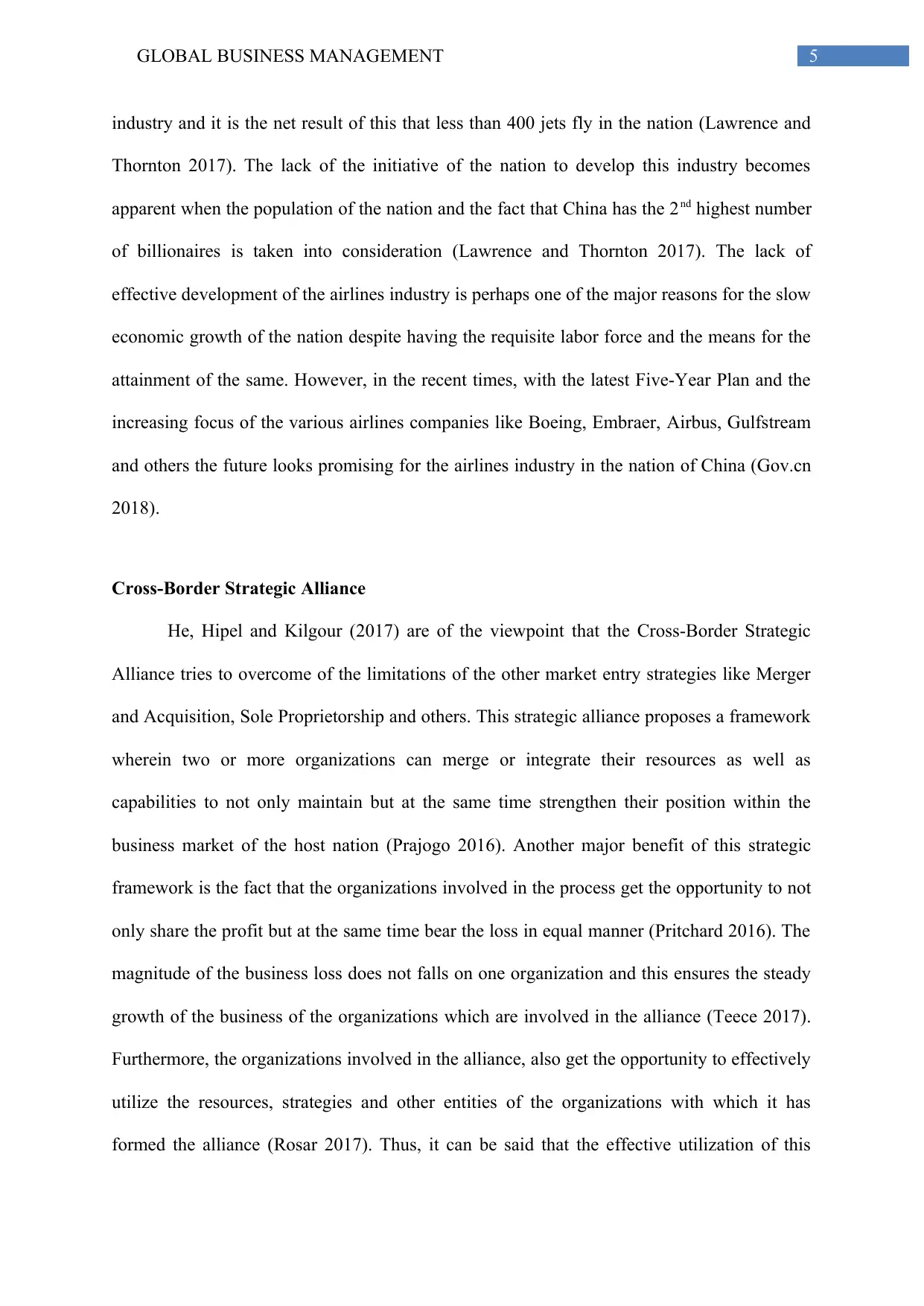
5GLOBAL BUSINESS MANAGEMENT
industry and it is the net result of this that less than 400 jets fly in the nation (Lawrence and
Thornton 2017). The lack of the initiative of the nation to develop this industry becomes
apparent when the population of the nation and the fact that China has the 2nd highest number
of billionaires is taken into consideration (Lawrence and Thornton 2017). The lack of
effective development of the airlines industry is perhaps one of the major reasons for the slow
economic growth of the nation despite having the requisite labor force and the means for the
attainment of the same. However, in the recent times, with the latest Five-Year Plan and the
increasing focus of the various airlines companies like Boeing, Embraer, Airbus, Gulfstream
and others the future looks promising for the airlines industry in the nation of China (Gov.cn
2018).
Cross-Border Strategic Alliance
He, Hipel and Kilgour (2017) are of the viewpoint that the Cross-Border Strategic
Alliance tries to overcome of the limitations of the other market entry strategies like Merger
and Acquisition, Sole Proprietorship and others. This strategic alliance proposes a framework
wherein two or more organizations can merge or integrate their resources as well as
capabilities to not only maintain but at the same time strengthen their position within the
business market of the host nation (Prajogo 2016). Another major benefit of this strategic
framework is the fact that the organizations involved in the process get the opportunity to not
only share the profit but at the same time bear the loss in equal manner (Pritchard 2016). The
magnitude of the business loss does not falls on one organization and this ensures the steady
growth of the business of the organizations which are involved in the alliance (Teece 2017).
Furthermore, the organizations involved in the alliance, also get the opportunity to effectively
utilize the resources, strategies and other entities of the organizations with which it has
formed the alliance (Rosar 2017). Thus, it can be said that the effective utilization of this
industry and it is the net result of this that less than 400 jets fly in the nation (Lawrence and
Thornton 2017). The lack of the initiative of the nation to develop this industry becomes
apparent when the population of the nation and the fact that China has the 2nd highest number
of billionaires is taken into consideration (Lawrence and Thornton 2017). The lack of
effective development of the airlines industry is perhaps one of the major reasons for the slow
economic growth of the nation despite having the requisite labor force and the means for the
attainment of the same. However, in the recent times, with the latest Five-Year Plan and the
increasing focus of the various airlines companies like Boeing, Embraer, Airbus, Gulfstream
and others the future looks promising for the airlines industry in the nation of China (Gov.cn
2018).
Cross-Border Strategic Alliance
He, Hipel and Kilgour (2017) are of the viewpoint that the Cross-Border Strategic
Alliance tries to overcome of the limitations of the other market entry strategies like Merger
and Acquisition, Sole Proprietorship and others. This strategic alliance proposes a framework
wherein two or more organizations can merge or integrate their resources as well as
capabilities to not only maintain but at the same time strengthen their position within the
business market of the host nation (Prajogo 2016). Another major benefit of this strategic
framework is the fact that the organizations involved in the process get the opportunity to not
only share the profit but at the same time bear the loss in equal manner (Pritchard 2016). The
magnitude of the business loss does not falls on one organization and this ensures the steady
growth of the business of the organizations which are involved in the alliance (Teece 2017).
Furthermore, the organizations involved in the alliance, also get the opportunity to effectively
utilize the resources, strategies and other entities of the organizations with which it has
formed the alliance (Rosar 2017). Thus, it can be said that the effective utilization of this
⊘ This is a preview!⊘
Do you want full access?
Subscribe today to unlock all pages.

Trusted by 1+ million students worldwide
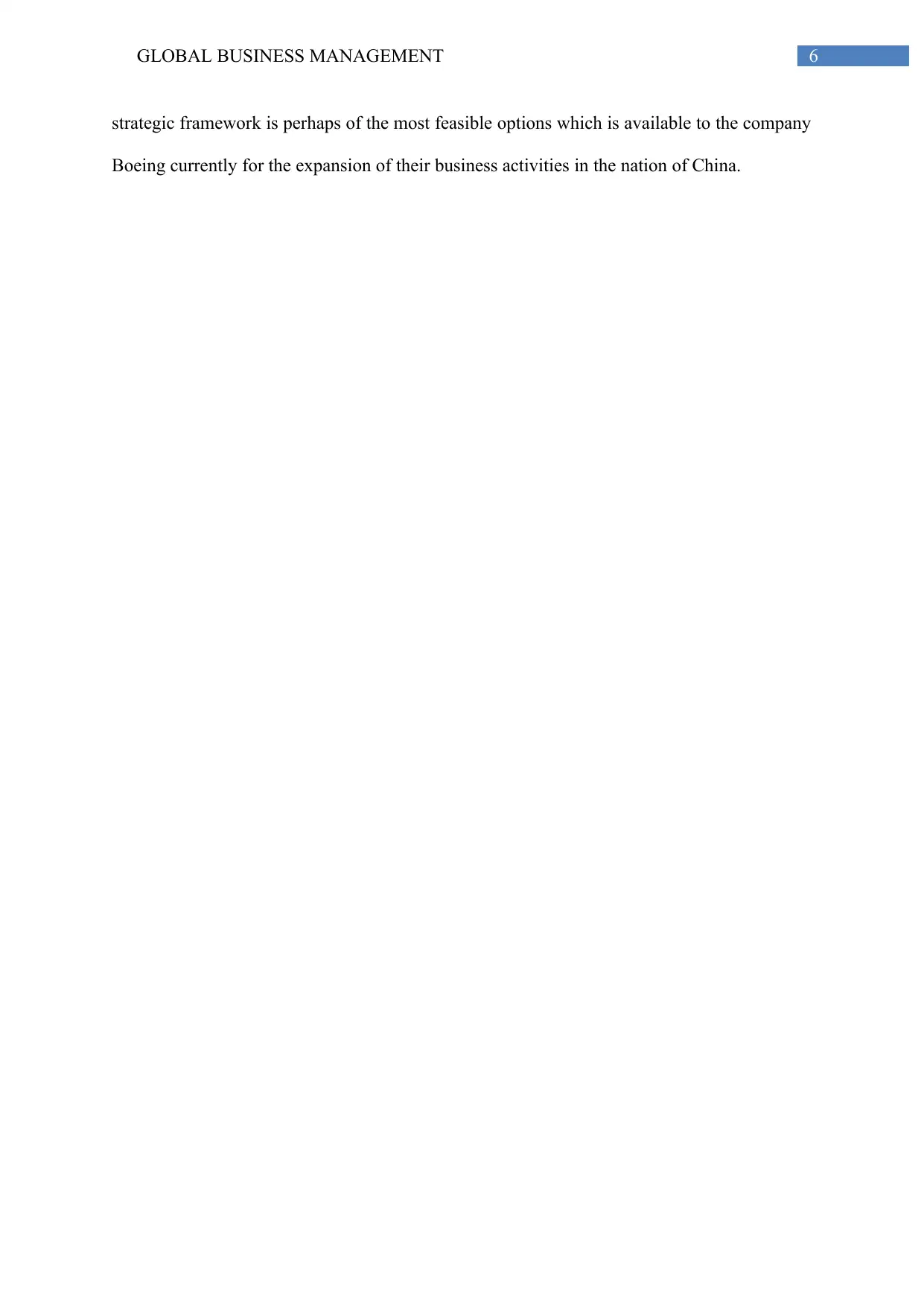
6GLOBAL BUSINESS MANAGEMENT
strategic framework is perhaps of the most feasible options which is available to the company
Boeing currently for the expansion of their business activities in the nation of China.
strategic framework is perhaps of the most feasible options which is available to the company
Boeing currently for the expansion of their business activities in the nation of China.
Paraphrase This Document
Need a fresh take? Get an instant paraphrase of this document with our AI Paraphraser
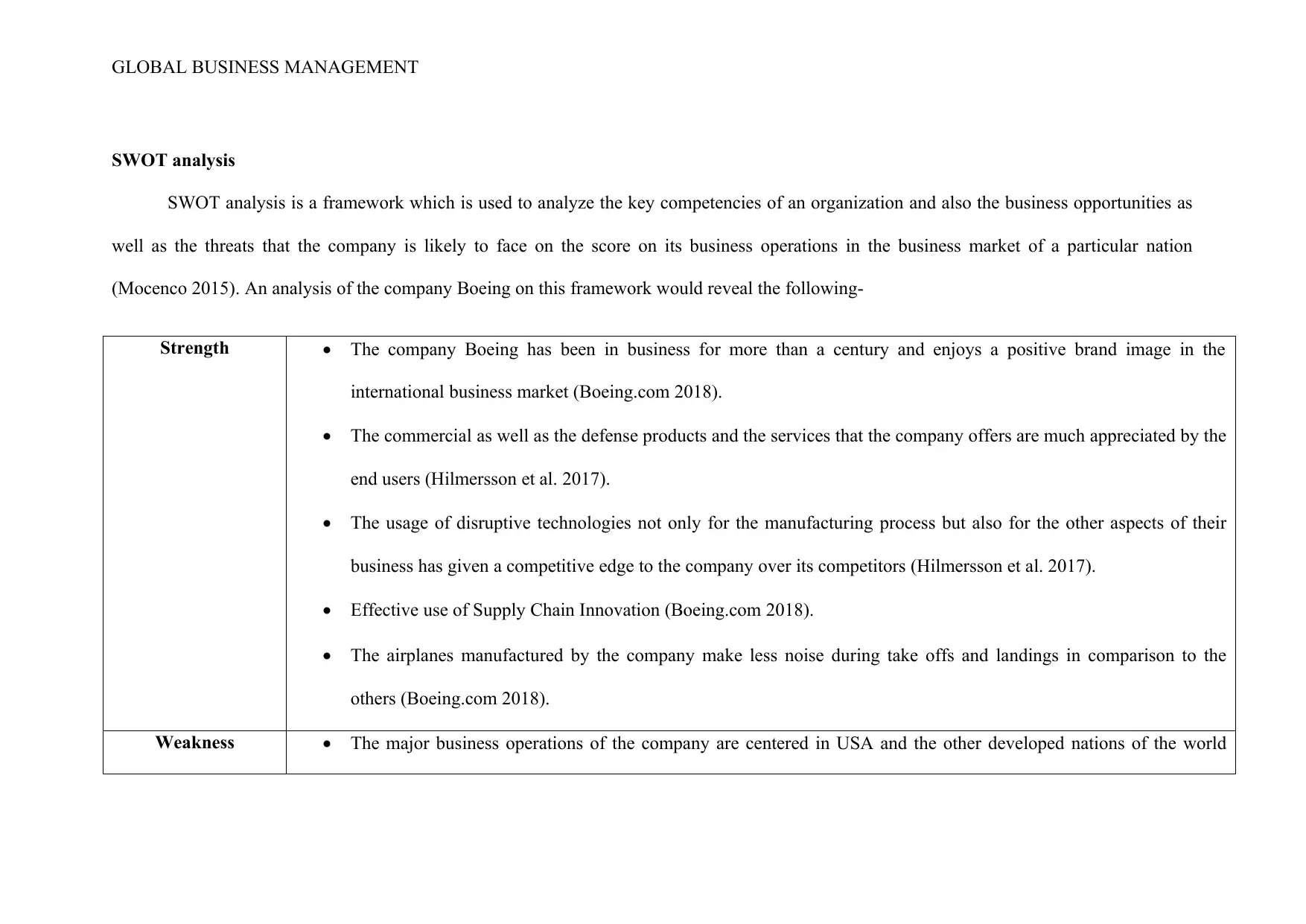
GLOBAL BUSINESS MANAGEMENT
SWOT analysis
SWOT analysis is a framework which is used to analyze the key competencies of an organization and also the business opportunities as
well as the threats that the company is likely to face on the score on its business operations in the business market of a particular nation
(Mocenco 2015). An analysis of the company Boeing on this framework would reveal the following-
Strength The company Boeing has been in business for more than a century and enjoys a positive brand image in the
international business market (Boeing.com 2018).
The commercial as well as the defense products and the services that the company offers are much appreciated by the
end users (Hilmersson et al. 2017).
The usage of disruptive technologies not only for the manufacturing process but also for the other aspects of their
business has given a competitive edge to the company over its competitors (Hilmersson et al. 2017).
Effective use of Supply Chain Innovation (Boeing.com 2018).
The airplanes manufactured by the company make less noise during take offs and landings in comparison to the
others (Boeing.com 2018).
Weakness The major business operations of the company are centered in USA and the other developed nations of the world
SWOT analysis
SWOT analysis is a framework which is used to analyze the key competencies of an organization and also the business opportunities as
well as the threats that the company is likely to face on the score on its business operations in the business market of a particular nation
(Mocenco 2015). An analysis of the company Boeing on this framework would reveal the following-
Strength The company Boeing has been in business for more than a century and enjoys a positive brand image in the
international business market (Boeing.com 2018).
The commercial as well as the defense products and the services that the company offers are much appreciated by the
end users (Hilmersson et al. 2017).
The usage of disruptive technologies not only for the manufacturing process but also for the other aspects of their
business has given a competitive edge to the company over its competitors (Hilmersson et al. 2017).
Effective use of Supply Chain Innovation (Boeing.com 2018).
The airplanes manufactured by the company make less noise during take offs and landings in comparison to the
others (Boeing.com 2018).
Weakness The major business operations of the company are centered in USA and the other developed nations of the world
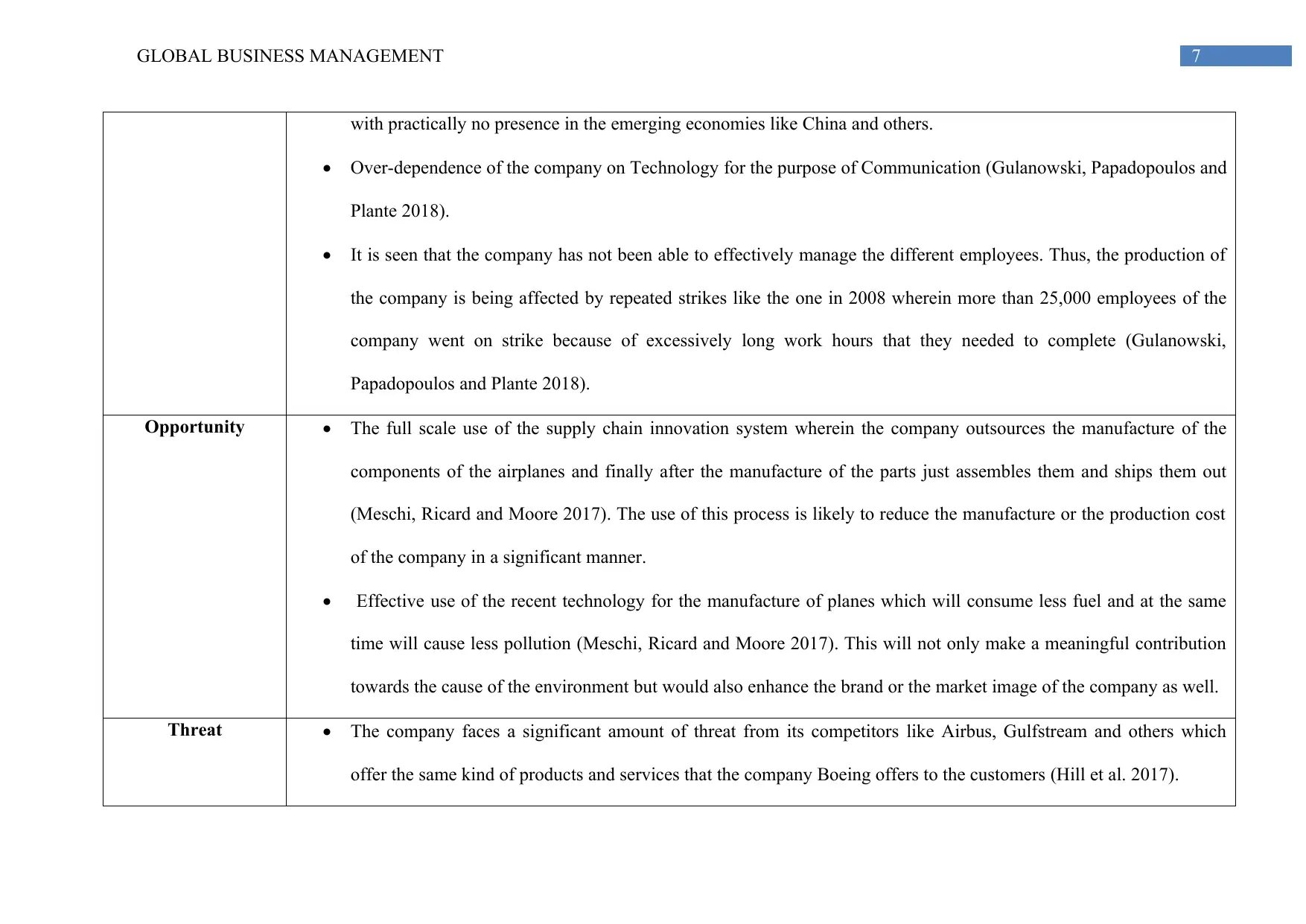
7GLOBAL BUSINESS MANAGEMENT
with practically no presence in the emerging economies like China and others.
Over-dependence of the company on Technology for the purpose of Communication (Gulanowski, Papadopoulos and
Plante 2018).
It is seen that the company has not been able to effectively manage the different employees. Thus, the production of
the company is being affected by repeated strikes like the one in 2008 wherein more than 25,000 employees of the
company went on strike because of excessively long work hours that they needed to complete (Gulanowski,
Papadopoulos and Plante 2018).
Opportunity The full scale use of the supply chain innovation system wherein the company outsources the manufacture of the
components of the airplanes and finally after the manufacture of the parts just assembles them and ships them out
(Meschi, Ricard and Moore 2017). The use of this process is likely to reduce the manufacture or the production cost
of the company in a significant manner.
Effective use of the recent technology for the manufacture of planes which will consume less fuel and at the same
time will cause less pollution (Meschi, Ricard and Moore 2017). This will not only make a meaningful contribution
towards the cause of the environment but would also enhance the brand or the market image of the company as well.
Threat The company faces a significant amount of threat from its competitors like Airbus, Gulfstream and others which
offer the same kind of products and services that the company Boeing offers to the customers (Hill et al. 2017).
with practically no presence in the emerging economies like China and others.
Over-dependence of the company on Technology for the purpose of Communication (Gulanowski, Papadopoulos and
Plante 2018).
It is seen that the company has not been able to effectively manage the different employees. Thus, the production of
the company is being affected by repeated strikes like the one in 2008 wherein more than 25,000 employees of the
company went on strike because of excessively long work hours that they needed to complete (Gulanowski,
Papadopoulos and Plante 2018).
Opportunity The full scale use of the supply chain innovation system wherein the company outsources the manufacture of the
components of the airplanes and finally after the manufacture of the parts just assembles them and ships them out
(Meschi, Ricard and Moore 2017). The use of this process is likely to reduce the manufacture or the production cost
of the company in a significant manner.
Effective use of the recent technology for the manufacture of planes which will consume less fuel and at the same
time will cause less pollution (Meschi, Ricard and Moore 2017). This will not only make a meaningful contribution
towards the cause of the environment but would also enhance the brand or the market image of the company as well.
Threat The company faces a significant amount of threat from its competitors like Airbus, Gulfstream and others which
offer the same kind of products and services that the company Boeing offers to the customers (Hill et al. 2017).
⊘ This is a preview!⊘
Do you want full access?
Subscribe today to unlock all pages.

Trusted by 1+ million students worldwide
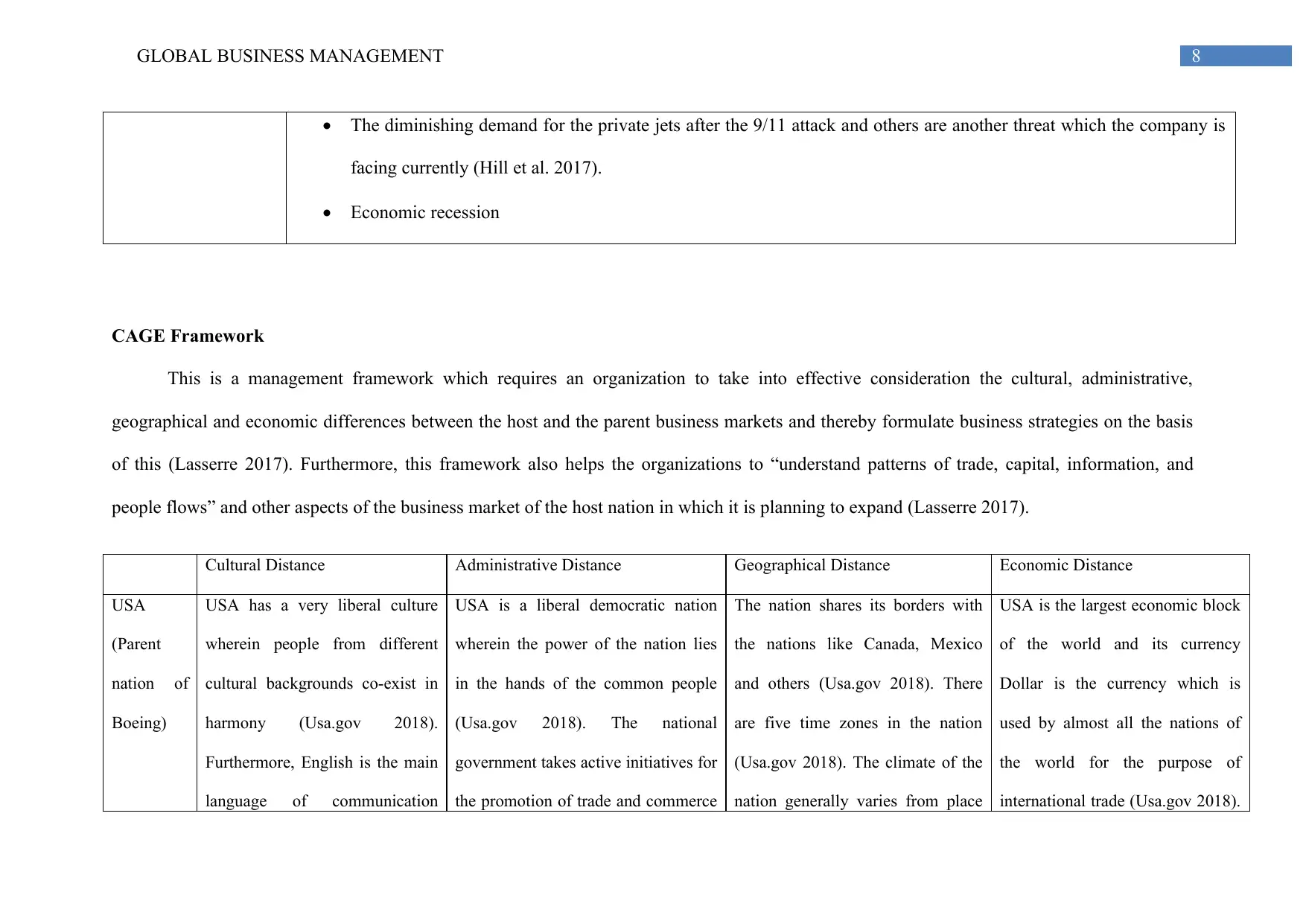
8GLOBAL BUSINESS MANAGEMENT
The diminishing demand for the private jets after the 9/11 attack and others are another threat which the company is
facing currently (Hill et al. 2017).
Economic recession
CAGE Framework
This is a management framework which requires an organization to take into effective consideration the cultural, administrative,
geographical and economic differences between the host and the parent business markets and thereby formulate business strategies on the basis
of this (Lasserre 2017). Furthermore, this framework also helps the organizations to “understand patterns of trade, capital, information, and
people flows” and other aspects of the business market of the host nation in which it is planning to expand (Lasserre 2017).
Cultural Distance Administrative Distance Geographical Distance Economic Distance
USA
(Parent
nation of
Boeing)
USA has a very liberal culture
wherein people from different
cultural backgrounds co-exist in
harmony (Usa.gov 2018).
Furthermore, English is the main
language of communication
USA is a liberal democratic nation
wherein the power of the nation lies
in the hands of the common people
(Usa.gov 2018). The national
government takes active initiatives for
the promotion of trade and commerce
The nation shares its borders with
the nations like Canada, Mexico
and others (Usa.gov 2018). There
are five time zones in the nation
(Usa.gov 2018). The climate of the
nation generally varies from place
USA is the largest economic block
of the world and its currency
Dollar is the currency which is
used by almost all the nations of
the world for the purpose of
international trade (Usa.gov 2018).
The diminishing demand for the private jets after the 9/11 attack and others are another threat which the company is
facing currently (Hill et al. 2017).
Economic recession
CAGE Framework
This is a management framework which requires an organization to take into effective consideration the cultural, administrative,
geographical and economic differences between the host and the parent business markets and thereby formulate business strategies on the basis
of this (Lasserre 2017). Furthermore, this framework also helps the organizations to “understand patterns of trade, capital, information, and
people flows” and other aspects of the business market of the host nation in which it is planning to expand (Lasserre 2017).
Cultural Distance Administrative Distance Geographical Distance Economic Distance
USA
(Parent
nation of
Boeing)
USA has a very liberal culture
wherein people from different
cultural backgrounds co-exist in
harmony (Usa.gov 2018).
Furthermore, English is the main
language of communication
USA is a liberal democratic nation
wherein the power of the nation lies
in the hands of the common people
(Usa.gov 2018). The national
government takes active initiatives for
the promotion of trade and commerce
The nation shares its borders with
the nations like Canada, Mexico
and others (Usa.gov 2018). There
are five time zones in the nation
(Usa.gov 2018). The climate of the
nation generally varies from place
USA is the largest economic block
of the world and its currency
Dollar is the currency which is
used by almost all the nations of
the world for the purpose of
international trade (Usa.gov 2018).
Paraphrase This Document
Need a fresh take? Get an instant paraphrase of this document with our AI Paraphraser
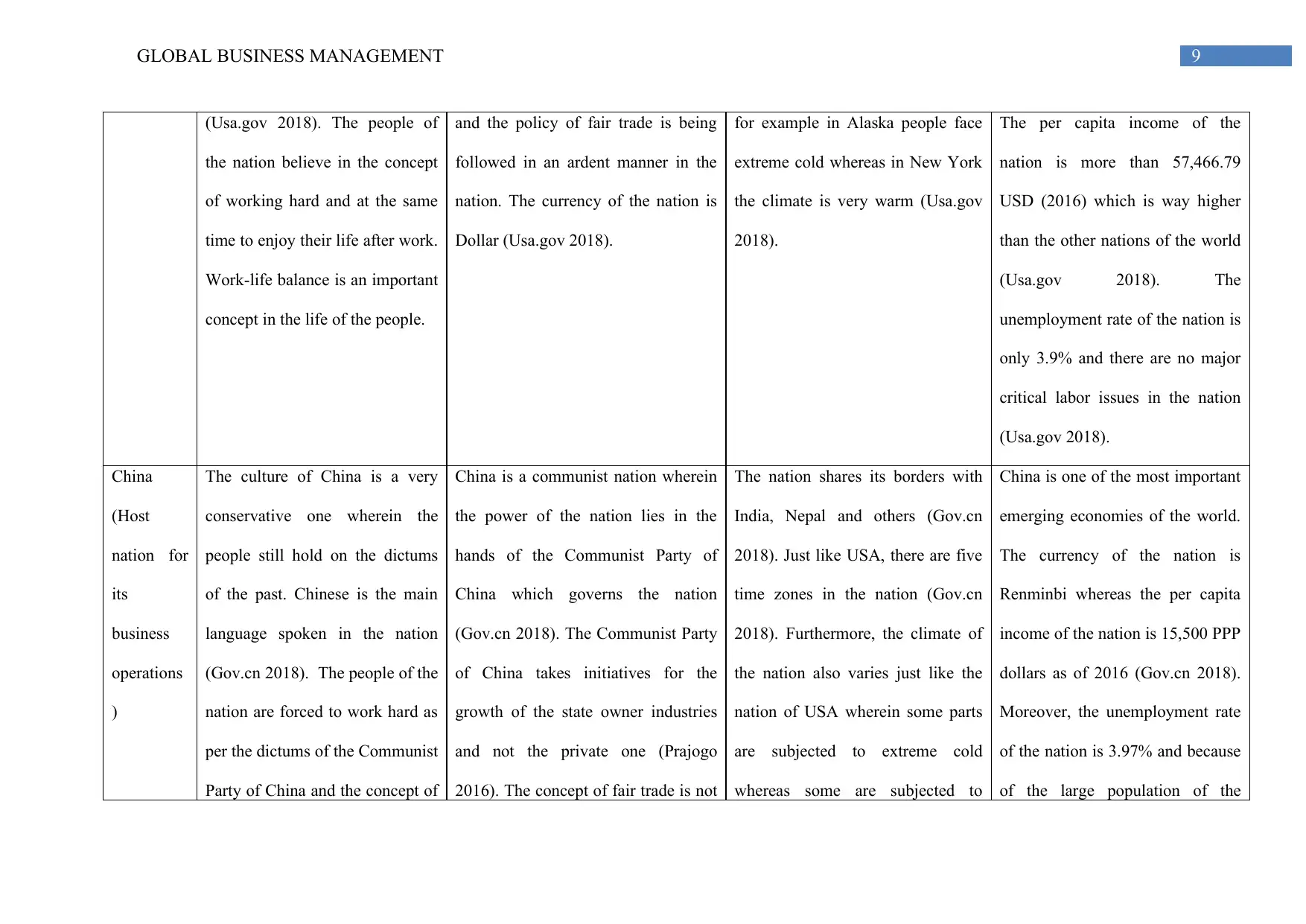
9GLOBAL BUSINESS MANAGEMENT
(Usa.gov 2018). The people of
the nation believe in the concept
of working hard and at the same
time to enjoy their life after work.
Work-life balance is an important
concept in the life of the people.
and the policy of fair trade is being
followed in an ardent manner in the
nation. The currency of the nation is
Dollar (Usa.gov 2018).
for example in Alaska people face
extreme cold whereas in New York
the climate is very warm (Usa.gov
2018).
The per capita income of the
nation is more than 57,466.79
USD (2016) which is way higher
than the other nations of the world
(Usa.gov 2018). The
unemployment rate of the nation is
only 3.9% and there are no major
critical labor issues in the nation
(Usa.gov 2018).
China
(Host
nation for
its
business
operations
)
The culture of China is a very
conservative one wherein the
people still hold on the dictums
of the past. Chinese is the main
language spoken in the nation
(Gov.cn 2018). The people of the
nation are forced to work hard as
per the dictums of the Communist
Party of China and the concept of
China is a communist nation wherein
the power of the nation lies in the
hands of the Communist Party of
China which governs the nation
(Gov.cn 2018). The Communist Party
of China takes initiatives for the
growth of the state owner industries
and not the private one (Prajogo
2016). The concept of fair trade is not
The nation shares its borders with
India, Nepal and others (Gov.cn
2018). Just like USA, there are five
time zones in the nation (Gov.cn
2018). Furthermore, the climate of
the nation also varies just like the
nation of USA wherein some parts
are subjected to extreme cold
whereas some are subjected to
China is one of the most important
emerging economies of the world.
The currency of the nation is
Renminbi whereas the per capita
income of the nation is 15,500 PPP
dollars as of 2016 (Gov.cn 2018).
Moreover, the unemployment rate
of the nation is 3.97% and because
of the large population of the
(Usa.gov 2018). The people of
the nation believe in the concept
of working hard and at the same
time to enjoy their life after work.
Work-life balance is an important
concept in the life of the people.
and the policy of fair trade is being
followed in an ardent manner in the
nation. The currency of the nation is
Dollar (Usa.gov 2018).
for example in Alaska people face
extreme cold whereas in New York
the climate is very warm (Usa.gov
2018).
The per capita income of the
nation is more than 57,466.79
USD (2016) which is way higher
than the other nations of the world
(Usa.gov 2018). The
unemployment rate of the nation is
only 3.9% and there are no major
critical labor issues in the nation
(Usa.gov 2018).
China
(Host
nation for
its
business
operations
)
The culture of China is a very
conservative one wherein the
people still hold on the dictums
of the past. Chinese is the main
language spoken in the nation
(Gov.cn 2018). The people of the
nation are forced to work hard as
per the dictums of the Communist
Party of China and the concept of
China is a communist nation wherein
the power of the nation lies in the
hands of the Communist Party of
China which governs the nation
(Gov.cn 2018). The Communist Party
of China takes initiatives for the
growth of the state owner industries
and not the private one (Prajogo
2016). The concept of fair trade is not
The nation shares its borders with
India, Nepal and others (Gov.cn
2018). Just like USA, there are five
time zones in the nation (Gov.cn
2018). Furthermore, the climate of
the nation also varies just like the
nation of USA wherein some parts
are subjected to extreme cold
whereas some are subjected to
China is one of the most important
emerging economies of the world.
The currency of the nation is
Renminbi whereas the per capita
income of the nation is 15,500 PPP
dollars as of 2016 (Gov.cn 2018).
Moreover, the unemployment rate
of the nation is 3.97% and because
of the large population of the
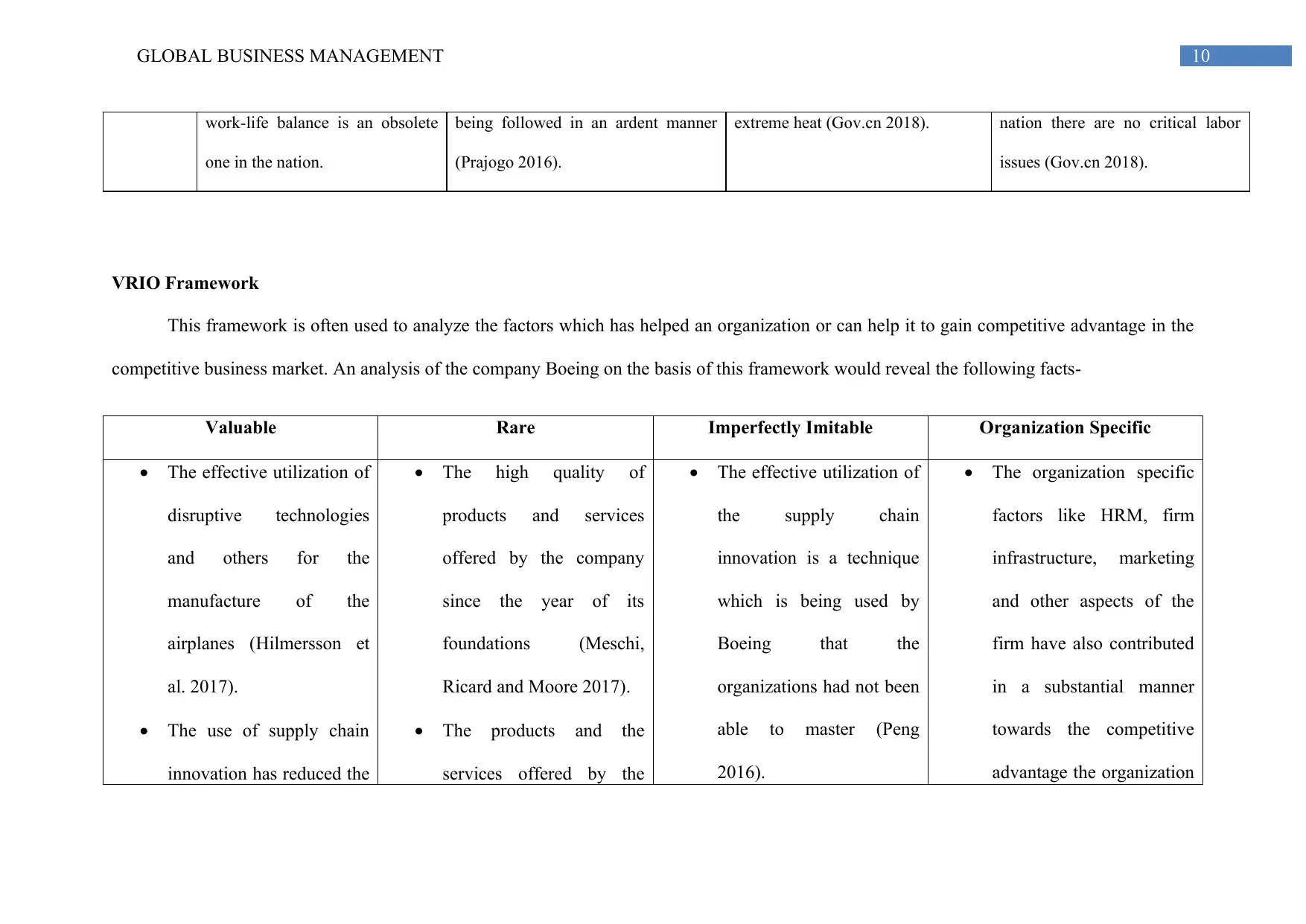
10GLOBAL BUSINESS MANAGEMENT
work-life balance is an obsolete
one in the nation.
being followed in an ardent manner
(Prajogo 2016).
extreme heat (Gov.cn 2018). nation there are no critical labor
issues (Gov.cn 2018).
VRIO Framework
This framework is often used to analyze the factors which has helped an organization or can help it to gain competitive advantage in the
competitive business market. An analysis of the company Boeing on the basis of this framework would reveal the following facts-
Valuable Rare Imperfectly Imitable Organization Specific
The effective utilization of
disruptive technologies
and others for the
manufacture of the
airplanes (Hilmersson et
al. 2017).
The use of supply chain
innovation has reduced the
The high quality of
products and services
offered by the company
since the year of its
foundations (Meschi,
Ricard and Moore 2017).
The products and the
services offered by the
The effective utilization of
the supply chain
innovation is a technique
which is being used by
Boeing that the
organizations had not been
able to master (Peng
2016).
The organization specific
factors like HRM, firm
infrastructure, marketing
and other aspects of the
firm have also contributed
in a substantial manner
towards the competitive
advantage the organization
work-life balance is an obsolete
one in the nation.
being followed in an ardent manner
(Prajogo 2016).
extreme heat (Gov.cn 2018). nation there are no critical labor
issues (Gov.cn 2018).
VRIO Framework
This framework is often used to analyze the factors which has helped an organization or can help it to gain competitive advantage in the
competitive business market. An analysis of the company Boeing on the basis of this framework would reveal the following facts-
Valuable Rare Imperfectly Imitable Organization Specific
The effective utilization of
disruptive technologies
and others for the
manufacture of the
airplanes (Hilmersson et
al. 2017).
The use of supply chain
innovation has reduced the
The high quality of
products and services
offered by the company
since the year of its
foundations (Meschi,
Ricard and Moore 2017).
The products and the
services offered by the
The effective utilization of
the supply chain
innovation is a technique
which is being used by
Boeing that the
organizations had not been
able to master (Peng
2016).
The organization specific
factors like HRM, firm
infrastructure, marketing
and other aspects of the
firm have also contributed
in a substantial manner
towards the competitive
advantage the organization
⊘ This is a preview!⊘
Do you want full access?
Subscribe today to unlock all pages.

Trusted by 1+ million students worldwide
1 out of 21
Related Documents
Your All-in-One AI-Powered Toolkit for Academic Success.
+13062052269
info@desklib.com
Available 24*7 on WhatsApp / Email
![[object Object]](/_next/static/media/star-bottom.7253800d.svg)
Unlock your academic potential
Copyright © 2020–2025 A2Z Services. All Rights Reserved. Developed and managed by ZUCOL.





